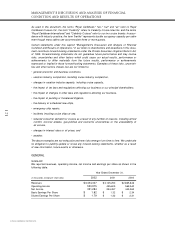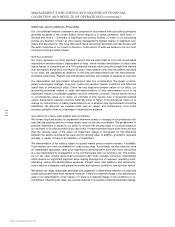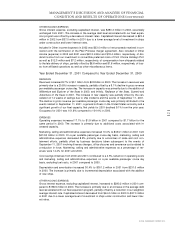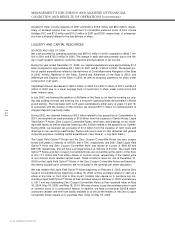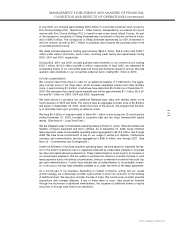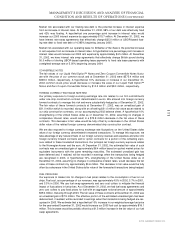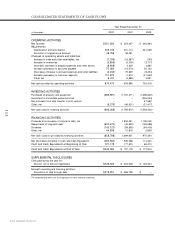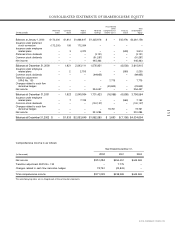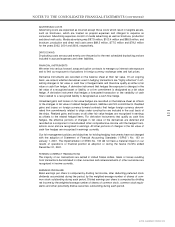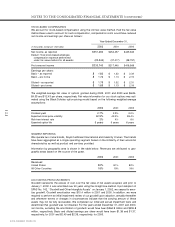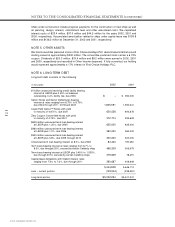Royal Caribbean Cruise Lines 2002 Annual Report Download - page 25
Download and view the complete annual report
Please find page 25 of the 2002 Royal Caribbean Cruise Lines annual report below. You can navigate through the pages in the report by either clicking on the pages listed below, or by using the keyword search tool below to find specific information within the annual report.
23
ROYAL CARIBBEAN CRUISES LTD.
MANAGEMENT'S DISCUSSION AND ANALYSIS OF FINANCIAL
CONDITION AND RESULTS OF OPERATIONS (continued)
Market risk associated with our floating rate debt is the potential increase in interest expense
from an increase in interest rates. At December 31, 2002, 58% of our debt was effectively fixed
and 42% was floating. A hypothetical one percentage point increase in interest rates would
increase our 2003 interest expense by approximately $15.7 million. At December 31, 2002, we
have interest rate swap agreements that effectively change $25.0 million of LIBOR-based float-
ing rate debt to fixed rate debt of 4.395% beginning January 2005.
Market risk associated with our operating lease for
Brilliance of the Seas
is the potential increase
in rent expense from an increase in interest rates. A hypothetical one percentage point increase in
interest rates would increase our 2003 rent expense by approximately $4.5 million. At December
31, 2002, we have interest rate swap agreements that effectively change British pound sterling
50.0 million of sterling LIBOR-based operating lease payments to fixed rate lease payments with
a weighted-average rate of 5.05% beginning January 2004.
CONVERTIBLE NOTES
The fair values of our Liquid Yield Option™ Notes and Zero Coupon Convertible Notes fluctu-
ate with the price of our common stock and at December 31, 2002 were $575.4 million and
$365.0 million, respectively. A hypothetical 10% decrease or increase in our December 31,
2002 common stock price would decrease or increase the value of our Liquid Yield Option™
Notes and Zero Coupon Convertible Notes by $10.2 million and $9.3 million, respectively.
FOREIGN CURRENCY EXCHANGE RATE RISK
Our primary exposure to foreign currency exchange rate risk relates to our firm commitments
under one ship construction contract denominated in euros. We entered into foreign currency
forward contracts to manage this risk and were substantially hedged as of December 31, 2002.
The fair value of these forward contracts at December 31, 2002, was an unrealized gain of
$31.0 million which is recorded, along with an offsetting $31.0 million fair value asset related to
our ship construction contracts, on our accompanying 2002 balance sheet. A hypothetical 10%
strengthening of the United States dollar as of December 31, 2002, assuming no changes in
comparative interest rates, would result in a $75.8 million decrease in the fair value of these
contracts. This decrease in fair value would be fully offset by a decrease in the United States
dollar value of the related foreign currency denominated ship construction contract.
We are also exposed to foreign currency exchange rate fluctuations on the United States dollar
value of our foreign currency denominated forecasted transactions. To manage this exposure, we
take advantage of any natural offsets of our foreign currency revenues and expenses and enter into
foreign currency forward contracts and/ or option contracts for a portion of the remaining expo-
sure related to these forecasted transactions. Our principal net foreign currency exposure relates
to the Norwegian kroner and the euro. At December 31, 2002, the estimated fair value of such
contracts was an unrealized gain of approximately $6.4 million based on quoted market prices for
equivalent instruments with the same remaining maturities. The estimated unrealized gain has
been deferred and, if realized, will be recorded in earnings when the transactions being hedged
are recognized in 2003. A hypothetical 10% strengthening of the United States dollar as of
December 31, 2002, assuming no changes in comparative interest rates, would decrease the fair
value of these contracts by approximately $3.6 million. This decrease in fair value would be fully
offset by a decrease in the United States dollar value of the forecasted transactions being hedged.
FUEL PRICE RISK
Our exposure to market risk for changes in fuel prices relates to the consumption of fuel on our
ships. Fuel cost, as a percentage of our revenues, was approximately 4.5% in 2002, 3.7% in 2001,
and 3.3% in 2000. We use fuel swap agreements and zero cost collars to mitigate the financial
impact of fluctuations in fuel prices. As of December 31, 2002, we had fuel swap agreements and
zero cost collars to pay fixed prices for fuel with an aggregate notional amount of approximately
$39.4 million, maturing through 2003. The fair value of these contracts at December 31, 2002 was
an unrealized gain of $7.5 million. The effective portion of the estimated unrealized gain has been
deferred and, if realized, will be recorded in earnings when the transactions being hedged are rec-
ognized in 2003. We estimate that a hypothetical 10% increase in our weighted-average fuel price
for the year ended December 31, 2002 would increase our 2003 fuel cost by approximately $18.1
million. This increase would be partially offset by a $1.5 million increase in the fair value of our fuel
swap agreements.



